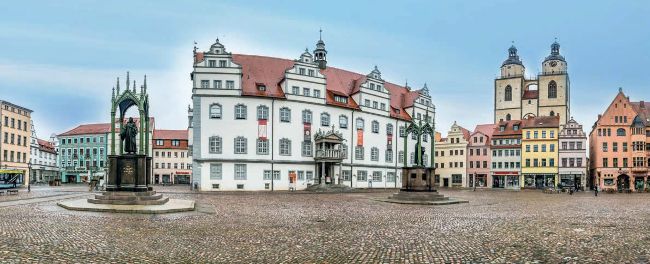Susan Hardman Moore traces the global impact of the Reformation.

Photos: iStock. The Main Square of Luther City Wittenberg in Germany
I am bound by the Scriptures I have quoted and my conscience is captive to the Word of God. I cannot and I will not retract anything, since it is neither safe nor right to go against conscience. I cannot do otherwise, here I stand, may God help me. Amen.
With these words, Martin Luther (1483-1546) defended his views before the Holy Roman Emperor, Charles V, at the Diet of Worms in 1521. Luther’s protest had started in 1517, in Wittenberg, with his Ninety-Five Theses.
Today, the small town of Wittenberg is a tourist magnet for those who want to know more about the German reformer. Souvenir-hunters should look out for the Luther socks: emblazoned, of course, ‘here I stand’.
2017 marks the 500th anniversary of the events that ignited the Reformation movement. Luther’s original protest centred on the preaching and practice of indulgences.
Pastorally, indulgences played an important role in the sacrament of confession: with an indulgence, people could substitute prayers or good works (which included gifts of money to the Church) for a more demanding form of penance. The link with money was becoming ever-more-important. Luther believed all this led people to misunderstand what true repentance meant.
Tradition says that on October 31 1517 he nailed his Ninety-Five Theses to a church door in Wittenberg, but what actually happened is unclear. That day, certainly, he fired off a copy to the Archbishop of Mainz, to lodge his complaint. He probably nailed up the Theses soon afterwards: it was common in a university town like Wittenberg to post documents for debate.
Then local printers spotted an opportunity and scattered Luther’s protest across Europe. The new technology of printing – like the internet today – revolutionised the spread of ideas.
The events of 1517 propelled Luther to notoriety, but it took time for his ideas to mature. His insights about ‘justification by faith alone’ probably took shape in the months that followed.
The roots of this ‘Reformation breakthrough’ lay partly in the controversy that engulfed him; partly in years of engagement with the Bible and Augustine’s theology; partly in his personal struggle with spiritual despair.
By 1520 Luther had set out his stall. Conflict with the authorities escalated. The pope excommunicated him, and in 1521 Luther stood before the emperor and refused to recant.
Within a few years – having renounced his monastic vows as works not faith – Luther married Katharina von Bora, and they and their six children turned Wittenberg’s monastery into a family home.
Luther was a larger-than-life character, with plenty of flaws. His legacy is complex (especially his later writings about the Jews, exploited in Nazi ideology) but there is no doubting his impact.
In Scotland, the decisive turn to Protestantism in 1560 came after Luther’s death, shaped by the Reformed thinkers Calvin and Knox.
Yet the first advocates of Reformation in Scotland – such as Patrick Hamilton, burnt as a heretic in St Andrews in 1528 – took inspiration from Luther.
From Wittenberg, Lutheranism expanded across Germany and Scandinavia; Lutheran migrants and missionaries planted churches in Africa, Asia, Australia and North America. Today, the Lutheran World Federation represents churches in 79 countries, with 72 million members.
For the 2017 commemorations of the Reformation, Lutherans and Catholics are keen to carve out common ground and put Luther into an ecumenical perspective.
A key document, From Conflict toCommunion, is available online. The 500th anniversary year began in October in Lund, Sweden: the preacher, Pope Francis.
Readers may be interested in a new biography by Timothy Lull and Derek Nelson, Resilient Reformer: the Life and Thought of Martin Luther (2015). Roland Bainton’s biography Here I Stand (1950) remains a classic.
Susan Hardman Moore is Professor of Early Modern Religion and Director of Postgraduate Studies at the University of Edinburgh.